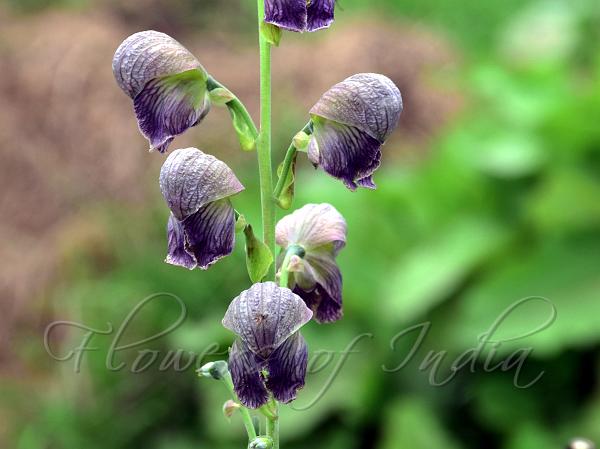|
| Greenish Himalayan Monkshood |
|

|

| File size | 592893 |
| Original date | 9/13/19 2:27 PM |
| Resolution | 4496 x 3000 |
| Flash | Flash did not fire |
| Focal length | 140.0mm |
| Exposure time | 1/100s |
| Aperture | 10.0 |
| Focus Distance | |
| Metering Mode | Spot |
| Camera make | NIKON CORPORATION |
| Camera model | NIKON D5300 |
| Sensor type | OneChipColorArea |
|
|
|
|
Photo: |
Botanical name: Aconitum heterophyllum Family: Ranunculaceae (Buttercup family)
Greenish Himalayan Monkshood is a perennial herb, 1-4 ft tall,
distinguished by its rather large greenish-purple, prominently
darker-veined flowers, and its coarsely toothed but otherwise entire
leaves. Flowers are 2.5-3 cm across, usually in lax, spike-like
clusters with very variable bracts which are either small linear, small
ovate, or large ovate and enclosing the lower part of the flower and
fruit. They are hooded, rounded, broader than long. Leaves are
ovate-heart-shaped to rounded, 4-8 cm, the upper ones stem-clasping,
all with large rounded teeth. Lowest leaves are deeply lobed and
long-stalked. At higher altitudes, sometimes plants are smaller in size.
Seed pods are 1.6-1.8 cm, shortly hairy, erect. Greenish Himalayan Monkshood is
found in the Himalayas, from Pakistan to C. Nepal, at altitudes of
2400-4000 m. Flowering: August-September.
Medicinal uses:  The dried root of Indian Atees is the part which is believed to have
analgesic, anti-inflammatory, antipyretic, anti-periodic, aphrodisiac,
astringent properties according to Ayurveda.
The dried root of Indian Atees is the part which is believed to have
analgesic, anti-inflammatory, antipyretic, anti-periodic, aphrodisiac,
astringent properties according to Ayurveda.
 The dried root of Indian Atees is the part which is believed to have
analgesic, anti-inflammatory, antipyretic, anti-periodic, aphrodisiac,
astringent properties according to Ayurveda.
The dried root of Indian Atees is the part which is believed to have
analgesic, anti-inflammatory, antipyretic, anti-periodic, aphrodisiac,
astringent properties according to Ayurveda. | Identification credit: Gurcharan Singh | Photographed in Deoban & Tungnath, Uttarakhand & Gulmarg, Kashmir. |
• Is this flower misidentified? If yes,